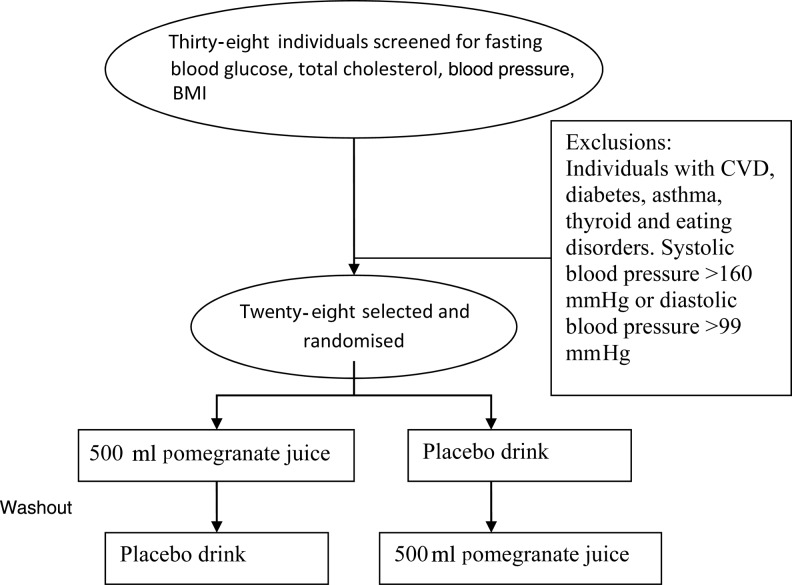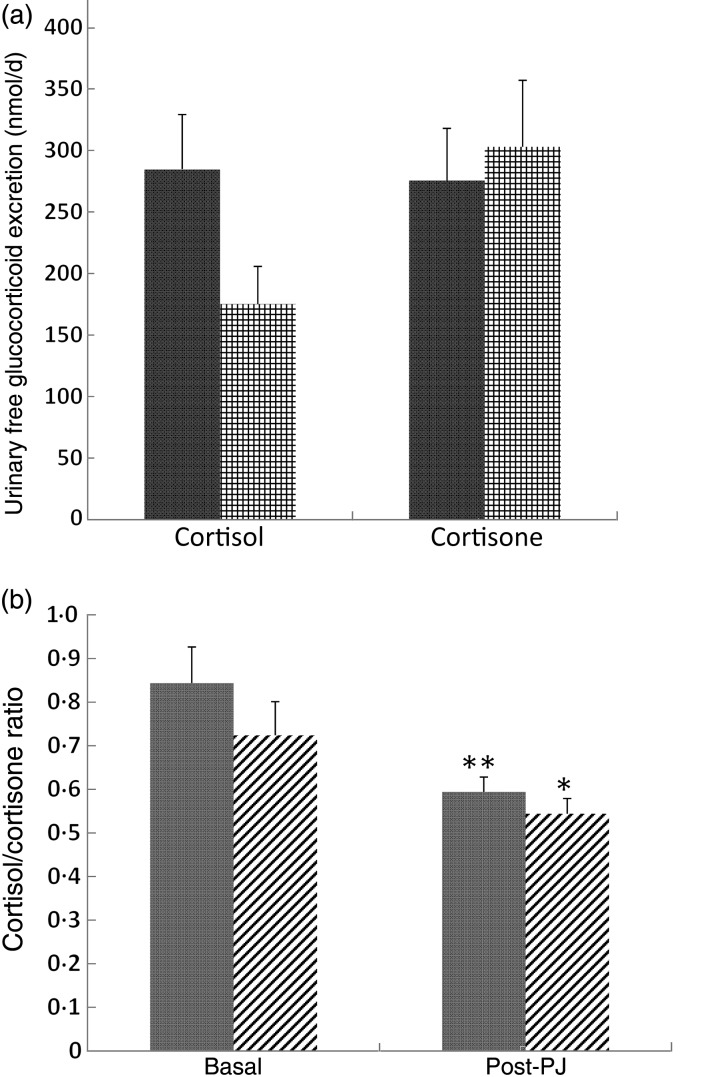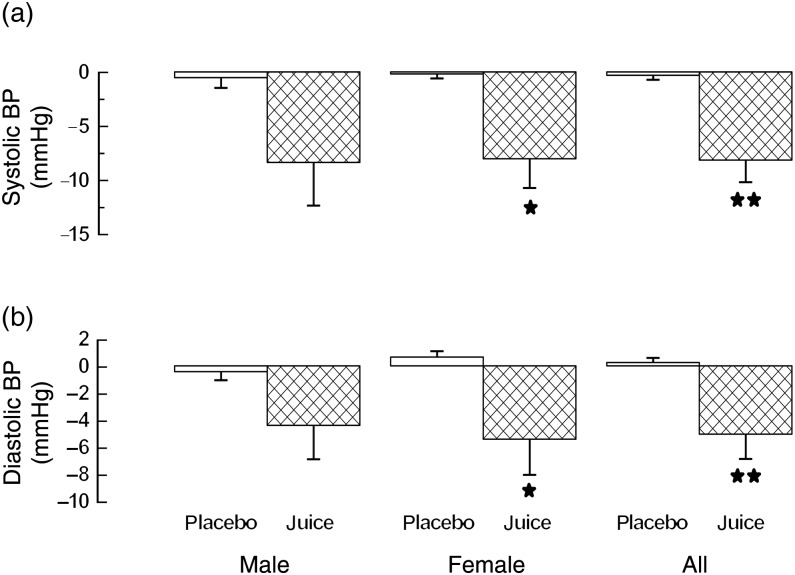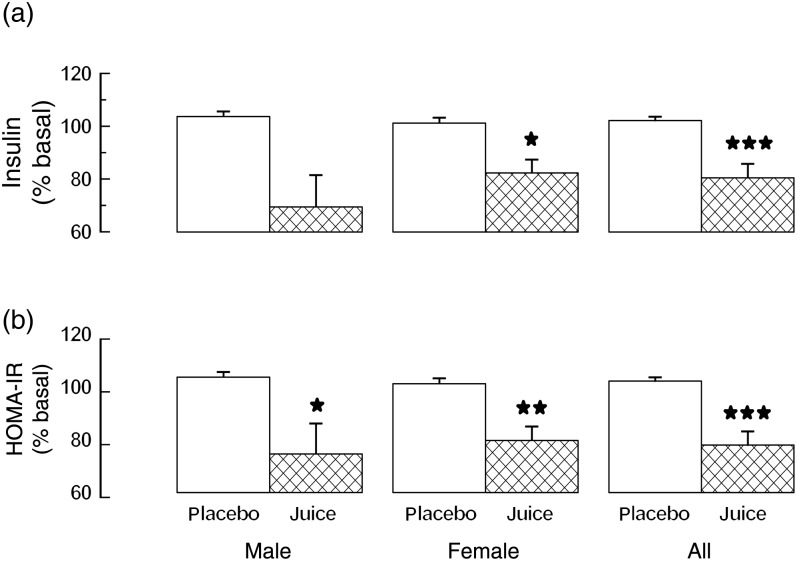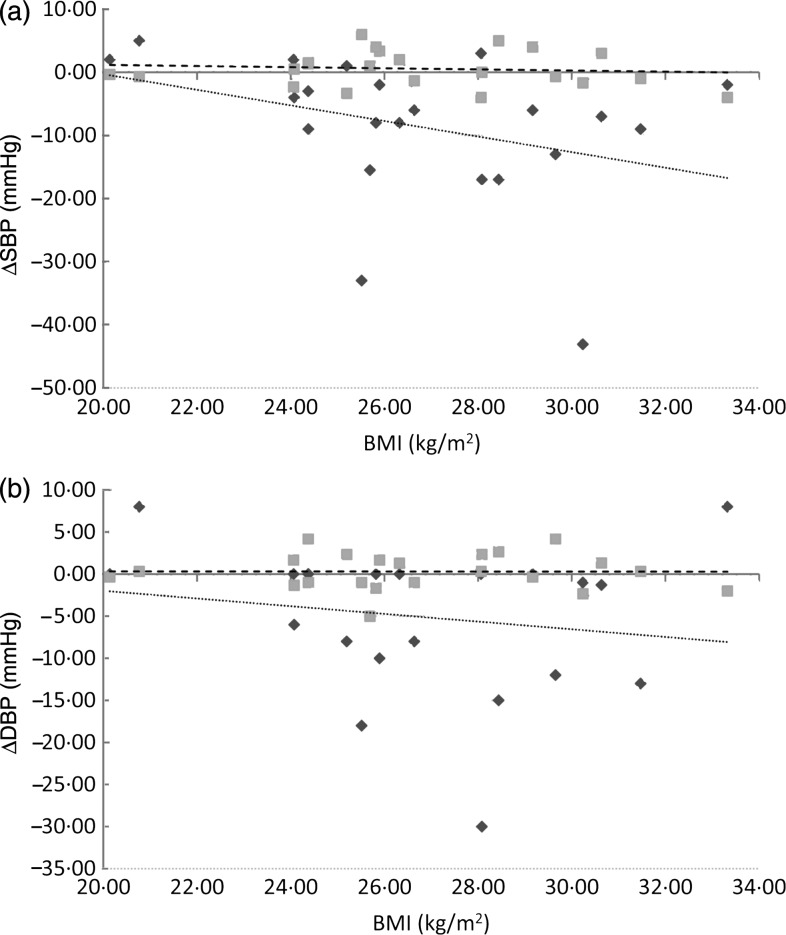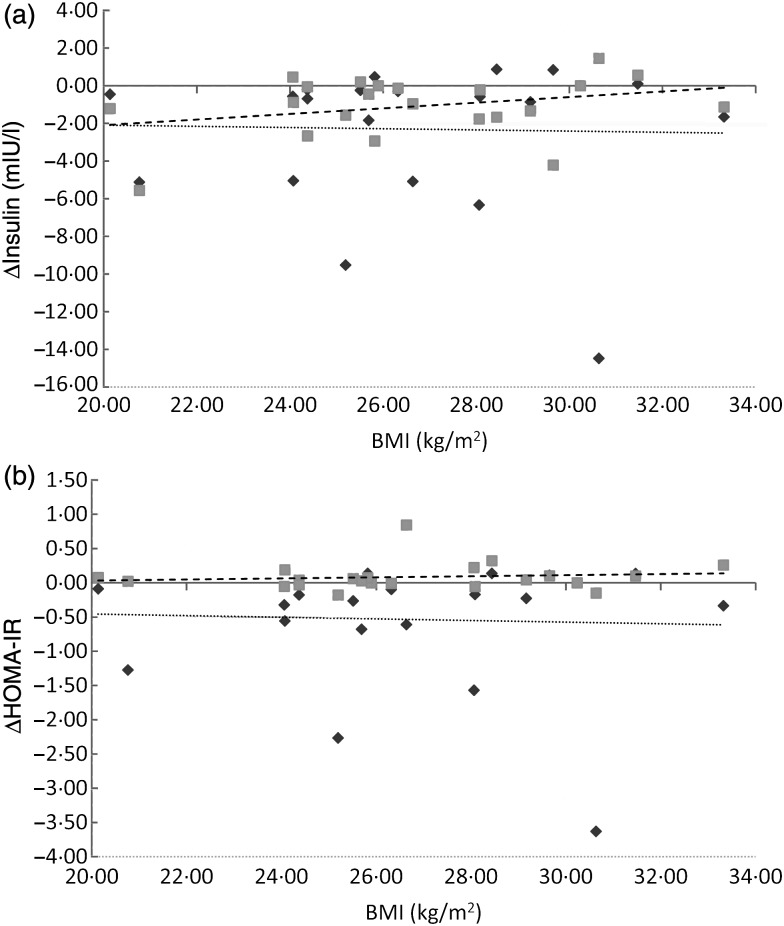Abstract
Pomegranate juice (PJ; also known as pomegreat pure juice) provides a rich and varied source of polyphenolic compounds that may offer cardioprotective, anti-atherogenic and antihypertensive effects. The aim of this study was to investigate the effect of PJ consumption on glucocorticoids levels, blood pressure (BP) and insulin resistance in volunteers at high CVD risk. Subjects (twelve males and sixteen females) participated in a randomised, placebo-controlled cross-over study (BMI: 26·77 (sd 3·36) kg/m2; mean age: 50·4 (sd 6·1) years). Volunteers were assessed at baseline, and at weeks 2 and 4 for anthropometry, BP and pulse wave velocity. Cortisol and cortisone levels in urine and saliva were determined by specific ELISA methods, and the cortisol/cortisone ratio was calculated. Fasting blood samples were obtained to assess plasma lipids, glucose, insulin and insulin resistance (homeostasis model assessment of insulin resistance). Volunteers consumed 500 ml of PJ or 500 ml of a placebo drink containing a similar amount of energy. Cortisol urinary output was reduced but not significant. However, cortisol/cortisone ratios in urine (P = 0·009) and saliva (P = 0·024) were significantly decreased. Systolic BP decreased from 136·4 (sd 6·3) to 128·9 (sd 5·1) mmHg (P = 0·034), and diastolic BP from 80·3 (sd 4·29) to 75·5 (sd 5·17) mmHg (P = 0·031) after 4 weeks of fruit juice consumption. Pulse wave velocity decreased from 7·5 (sd 0·86) to 7·44 (sd 0·94) m/s (P = 0·035). There was also a significant reduction in fasting plasma insulin from 9·36 (sd 5·8) to 7·53 (sd 4·12) mIU/l (P = 0·025) and of homeostasis model assessment of insulin resistance (from 2·216 (sd 1·43) to 1·82 (sd 1·12), P = 0·028). No significant changes were seen in the placebo arm of the study. These results suggest that PJ consumption can alleviate key cardiovascular risk factors in overweight and obese subjects that might be due to a reduction in both systolic and diastolic BP, possibly through the inhibition of 11β-hydroxysteroid dehydrogenase type 1 enzyme activity as evidenced by the reduction in the cortisol/cortisone ratio. The reduction in insulin resistance might have therapeutic benefits for patients with non-insulin-dependent diabetes, obesity and the metabolic syndrome.
Key words: Pomegranate juice, Blood pressure, Glucocorticoids, Obesity, 11β-Hydroxysteroid dehydrogenase, Homeostasis model assessment of insulin resistance
Abreviations: 11β-HSD, 11β-hydroxysteroid dehydrogenase; BP, blood pressure; DBP, diastolic blood pressure; FRAP, ferric-reducing antioxidant power; HOMA-IR, homeostasis model assessment of insulin resistance; PJ, pomegranate juice; SBP, systolic blood pressure.
CVD is a major cause of mortality in Western countries, particularly in Scotland where death rates are among the highest in the world. Dietary factors represent a key component of the disease and specific dietary constituents are considered to be important to health. Polyphenols are secondary metabolites widespread in the plant kingdom and form an integral part of the human diet where it has been estimated that their total dietary intake may be as high as 1 g/d( 1 ). Polyphenols have perceived health benefits in their ability to neutralise free radicals and reactive oxygen species, and thus cardiovascular health may be improved, as LDL-cholesterol has a reduced capacity to be oxidised and therefore to reduce atherogenicity and platelet aggregation( 2 – 4 ). The pomegranate (Punica granatum L.) has been a medicinal food throughout history. Pomegranate juice (PJ; also known as pomegreat pure juice) might have potent antioxidant and anti-atherosclerotic properties attributed to its abundance of polyphenols including ellagic acids, gallotannins and anthocyanins (cyanidin, delphinidin and pelargonidin glycosides) and other flavonoids. The most abundant of these polyphenols is punicalagin, an ellagitannin implicated as the bioactive constituent responsible for >50 % of the juice's antioxidant activity( 5 , 6 ). Numerous studies have been carried out for the identification and quantification of phenolic compounds and their effects on antioxidant activity of PJ in human subjects and animals( 7 – 9 ), and have concluded that most pomegranate flavonoids and ellagitannins such as punicalagin and ellagic acid can be detected in the plasma and urine. However, the levels were found to be lower than expected, which could be due to the fact that the bioavailability process is complicated with large individual variations and requires further investigation using a large number of volunteers. In addition, it was also discovered that even ellagic acid metabolites such as urolithins A and B and their glucuronide and sulphate derivatives are biologically active( 10 – 12 ).
Several studies have demonstrated that consumption of PJ can exert positive effects on cardiovascular risk, hypertension, atherosclerosis, endothelial dysfunction and inflammation( 13 – 15 ). Clinical studies have shown a beneficial effect on vascular health following PJ consumption, with reduced systolic blood pressure (SBP), enhanced antioxidant status and improved insulin resistance in type 2 diabetic and hypertensive patients( 13 , 15 , 16 ). In addition, some researchers have shown that PJ consumption reduces carotid intima-media thickness and blood pressure (BP)( 14 , 17 ). As powerful antioxidants, phenolics may protect the body from damaging oxidation reactions( 18 , 19 ); however, other mechanisms may also operate which are currently under investigation. In a limited study of hypertensive patients, consumption of PJ for 2 weeks was shown to reduce SBP by inhibiting serum angiotensin-converting enzyme( 15 ). Obesity and diabetes are other underlying factors linked to metabolic and cardiovascular risk( 14 ) as well as abnormal cortisol levels and metabolism( 20 ).
The importance of cortisol in regulating BP has been highlighted in several conditions, and chronic excessive activation of the glucocorticoid receptor is known to induce obesity, insulin resistance, glucose intolerance and hypertension( 21 ). Glucocorticoids exert a direct effect on the heart and blood vessels via 11β-hydroxysteroid dehydrogenase type 1 enzyme (11β-HSD1) and 11β-HSD2. Increased 11β-HSD1 activity is implicated in the development of the metabolic syndrome and identifying dietary constituents that influence 11β-HSD1 activity could lead to novel methods of preventing CVD and associated risk factors. The association between excess cortisol and various parameters of the metabolic syndrome, including hypertension and insulin resistance, is now increasingly recognised( 22 , 23 ). The aim of the present study was to examine the influence of a 4-week consumption of PJ (Pomegreat Pure®) containing 1685 mg/l polyphenols on salivary and urinary cortisol and cortisone levels, and their ratio as indicative of the activity of 11β-HSD enzymes. In addition, the assessment of cardiometabolic risk factors: BP, arterial compliance, plasma lipid profile, glucose, insulin and insulin resistance, in a high-risk group (age 40–65 years) of apparently healthy male and female participants will be made.
Experimental methods
Study design
The study used a randomised, placebo-controlled, cross-over design (Fig. 1). Following a 1-week run-in phase, eligible subjects were randomly assigned to receive 500 ml PJ containing 1685 mg/l polyphenols or 500 ml placebo (water placed in a dark container plus the addition of equivalent carbohydrates to match the energy content of the juice). Participants followed each intervention for 4 weeks, after which they were crossed over to the next intervention separated by a 1-week washout period. Participants were provided with a list of phenolic-rich foods to avoid including green tea, red wine, dark chocolate and berries. Compliance with the dietary restrictions was monitored with a 3-d food diary record. Compliance was also measured by assessing the total phenolic content of 24 h urine samples collected at baseline, the mid-point and at the end of the study period. All participants provided written informed consent and a lifestyle questionnaire to determine their eligibility. The study was conducted at Queen Margaret University and the protocol was approved by Queen Margaret University Research Ethics Committee. This study was conducted according to the guidelines laid down in the Declaration of Helsinki and all procedures involving human subjects were approved by the Queen Margaret University Research Ethics Central Committee. Written informed consent was obtained from all subjects and has been recorded and stored according to the university guidelines.
Fig. 1.
Flow diagram of the study design protocol.
Inclusion and exclusion criteria
Participants were recruited by an email moderator advertisement at Queen Margaret University, Edinburgh, UK. Volunteers were aged between 40 and 65 years with a BMI between 25 and 35 kg/m2. Only those sedentary or moderately active (defined as less than two aerobic sessions per week) were included. Participants were excluded if they presented with signs of the metabolic syndrome, i.e. fasting plasma glucose >6·1 mmol/l, TAG level >1·7 mmol/l, low HDL-cholesterol (<1·01 mmol/l for men and <1·25 mmol/l for women), hypertension, central obesity (waist circumference >108 cm for men and >88 cm for women) or if they had moderate hypercholesterolaemia. Individuals were excluded also if they reported to have CVD, diabetes, asthma, SBP >160 mmHg or diastolic blood pressure (DBP) >99 mmHg. Individuals with thyroid gland disorders or eating disorders, as well as those taking regular medication or nutritional supplements (such as antioxidants or fish oil) known to affect any dependent variable measured, were also excluded.
Materials and chemicals
Gallic acid and Folin–Ciocalteau's phenol regent were purchased from Sigma. Methanol (HPLC grade) and HCl were purchased from Rathburn Chemicals. Acetone, acetic acid (glacial) and Na2HPO4 were obtained from Fisher Scientific. Na2CO3, disodium hydrogen orthophosphate and sodium dihydrogen orthophosphate dehydrate were purchased from BDH Chemicals Ltd. All other chemicals and reagents were obtained from Sigma unless otherwise stated.
Measurements
Fasted blood was collected at baseline and at the end of the 4-week intervention period. Plasma was obtained by centrifugation (at 1500 g for 10 min) within 30 min of blood collection and stored frozen at −80°C prior to analysis. Plasma lipids and glucose analyses were undertaken at the Clinical Biochemistry Laboratory, Western General Hospital, Edinburgh, Scotland, UK using an automated platform (Olympus). Fasting plasma insulin was estimated using a sensitive human Insulin ELISA kit (GenWay), and insulin resistance (homeostasis model assessment of insulin resistance (HOMA-IR)) was calculated by the method of Turner and co-workers( 24 ) using the formula HOMA-IR = fasting glucose × fasting insulin/22·5. Unstimulated saliva samples were collected (08.00 hours, noon and 18.00 hours) from volunteers in sterile plastic containers at baseline and after 4 weeks of the juice or placebo intake.
Serum NEFA were quantified using an automated enzymatic colorimetric method (Wako) at the Rowett Institute of Nutrition and Health, Aberdeen, UK. Urinary and plasma levels of total polyphenols( 25 ) and ferric-reducing antioxidant power (FRAP)( 26 ) were measured by established methods. Plasma levels of total phenolics were assessed by a modification of the Folin–Ciocalteau method as described by Serafini et al.( 27 ). Cortisol and cortisone levels in saliva and urine samples were estimated by using highly specific and sensitive ELISA methods published previously( 28 ). The ratio of cortisol to cortisone was calculated to give an indication of the activity of 11β-HSD1. All samples from the same subject were tested on the same day to prevent any inter-day variation. A validated automated A&D Medical UA-767 BP monitor (A&D Medical) was used to measure BP according to Grassi et al.( 29 ). Three readings of BP were usually taken at each visit and the average was calculated. Arterial compliance was assessed by pulse wave velocity using a Vicorder™, (Skidmore Medical), and again three measurements were taken at each visit.
Statistical analysis
All statistical analyses were performed using SPSS for Windows, version 16.10 (SPSS Inc.). P ≤ 0·05 was considered significant. Continuous normally distributed data are expressed as mean values and standard deviations unless otherwise stated. Differences in baseline characteristics were examined using an independent-samples paired Student's t test with BMI, age, waist circumference, fasting insulin, glucose, lipid profile, BP, urinary and plasma total polyphenols and FRAP as the dependent variables. ANOVA were conducted using the general linear model procedure to assess the differences in the effect of PJ and placebo on outcome measures. The models included the main effects of treatment, time and treatment–time interaction. Bonferroni adjustment was used to account for multiple testing.
To examine whether the effect of PJ on BP, insulin and HOMA-IR was dependent on BMI, we also ran a series of linear regression models. Changes in BP, insulin and HOMA-IR were modelled as dependent variables. BMI, treatment and BMI–treatment interaction were fitted as predictors, as shown in the following equation:
where y is the change in outcome from the baseline per person per treatment group; x1 is the dummy variable, 0 for placebo and 1 for PJ; x2 is the BMI expressed as a continuous variable; x3 is the product term for dummy variable and BMI; and a1–4 is the β coefficients.
Results
Subjects
Eligible participants were aged between 40 and 65 years with a BMI between 25 and 35 kg/m2 (Table 1). In this randomised, placebo-controlled, cross-over study, twenty-eight volunteers (twelve males and sixteen females) completed the study and each consumed 500 ml/d of PJ for a period of 4 weeks. Of the total number recruited, eight were excluded for one of the reasons mentioned in Fig. 1 and two subjects dropped out of the study due to the inconvenience of travelling to the university campus following baseline assessment.
Table 1.
Anthropometric, pulse wave velocity (PWV), ferric-reducing antioxidant power (FRAP), total phenolics (TP), plasma cholesterol and lipid profile measurements at baseline and following 2 and 4 weeks of pomegranate juice consumption (Mean values and standard deviations)
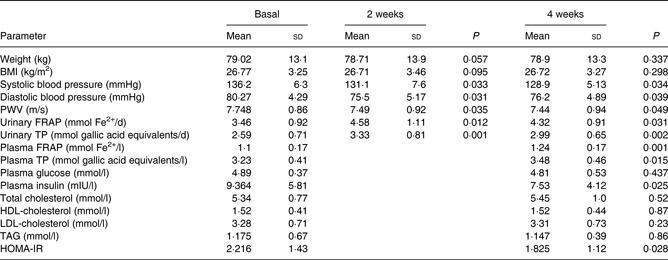
HOMA-IR, homeostasis model assessment of insulin resistance.
Anthropometric and metabolic results
The 4-week intervention did not significantly change plasma levels of lipids (total cholesterol, TAG, LDL-cholesterol or HDL-cholesterol) or glucose concentrations, which were all within the anticipated physiological range (Table 1). There was a significant reduction in pulse wave velocity after 2 weeks (P = 0·035) and 4 weeks of PJ consumption. There was also a significant reduction in both SBP and DBP in the treatment group compared with the control group (Table 1), SBP from 136·2 (sd 6·3) to 131·1 (sd 7·6) (P = 0·033) to 128·9 (sd 5·1) mmHg (P = 0·034) after 2 and 4 weeks, respectively. DBP decreased from 80·27 (sd 4·29) to 75·5 (sd 5·17) mmHg (P = 0·031) after 2 weeks of fruit juice consumption.
No significant changes in body weight or BMI were observed; however, eleven of the twenty-one participants showed a decrease in plasma NEFA levels following fruit juice consumption for 4 weeks (from 0·483 (sd 0·16) to 0·396 (sd 0·14) mmol/l, P = 0·017), and this was not observed in the placebo group. Plasma antioxidant capacity was significantly increased following 4 weeks of PJ intake; FRAP increased from 1098 (sd 170·5) to 1241 (sd 173·7) μmol Fe(II)/l (P = 0·001) following fruit juice consumption. Plasma total phenols were also significantly increased from 3·23 (sd 0·41) to 3·48 (sd 0·46) mmol gallic acid equivalents/l (P = 0·015). Urinary antioxidant capacity was significantly increased following 2 and 4 weeks of PJ intake. After 2 weeks, the FRAP level went up from 3·46 (sd 0·92) to 4·58 (sd 1·11) mmol Fe(II)/d (P = 0·012). The urinary total phenolics level was also significantly increased from 2·59 (sd 0·71) to 3·33 (sd 0·81) mmol gallic acid equivalents/d (P = 0·001). There was no significant change in the plasma lipid profile, BP, fasting glucose and insulin, plasma and urinary FRAP and total phenolics following the placebo arm of the study (Table 2).
Table 2.
Blood pressure (BP), pulse wave velocity (PWV), plasma cholesterol and lipid profile measurements at baseline and following 4 weeks of placebo drink consumption (Mean values and standard deviations)
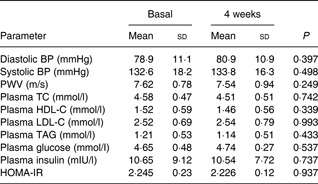
TC, total cholesterol; HDL-C, HDL-cholesterol; LDL-C, LDL-cholesterol; HOMA-IR, homeostasis model assessment of insulin resistance.
Hormonal results
The results of cortisol and cortisone levels are shown in Fig. 2. Urinary free cortisol levels were reduced following PJ consumption compared to basal values, but not significantly. No significant difference was obtained in urinary free cortisone output. When the free cortisol/cortisone ratio was calculated, there was a significant reduction in urinary (P = 0·009) and salivary ratios (P = 0·024), indicating a possible effect on 11β-HSD1 activity. Placebo data showed no significant difference (the urinary basal ratio was 1·029 (sd 0·28) and post-placebo 1·042 (sd 0·34)). There was a significant reduction of fasting plasma insulin levels from 9·364 (sd 5·81) to 7·53 (sd 4·12) mIU/l (P = 0·025) and of insulin resistance (HOMA-IR) from 2·216 (sd 1·43) to 1·825 (sd 1·12) (P = 0·028) (Table 1). There was no significant change in all the parameters tested following the placebo arm of the study (Table 2).
Fig. 2.
Glucocorticoid results. (a) Urinary free cortisol and cortisone outputs at baseline (■) and post-pomegranate juice (PJ; ▒) and (b) urinary (▓) and salivary (///) free cortisol/cortisone ratios. Values are means, with standard errors represented by vertical bars. Mean value was significantly reduced following pomegranate juice intake compared with baseline: * P = 0·024, ** P = 0·009.
Blood pressure, insulin and homeostasis model of insulin resistance results
The effect on SBP, DBP, insulin and HOMA-IR was also studied using ANOVA. Here the changes in response between the basal and the intervention (pomegranate or placebo) were calculated, and the results are shown in Figs. 3 and 4. For BP scores, the data were analysed using the differences between the basal values and those following PJ or placebo intake. The effects of PJ intake compared with the placebo were significant for all the variables when both males and females were pooled (Fig. 3). Separately, the effects in males were not always significant, but in females, the differences were. For the effect on plasma insulin and HOMA-IR (Fig. 4), the percentage differences from basal values were analysed (e.g. 100 × basal insulin/insulin PJ and 100 × basal insulin/insulin placebo). Again, the results indicate that a significance effect was more apparent when all the data were pooled together.
Fig. 3.
Effect of pomegranate juice consumption on blood pressure (BP) reduction. There were significant reductions in systolic BP (a) and diastolic BP (b) differences from basal values when both male and female data were pooled. Separate effects in males were not always significant, but those in females were. Values are means, with standard errors represented by vertical bars. * P < 0·05, ** P < 0·01.
Fig. 4.
Effect of pomegranate juice consumption on insulin (a) and homeostasis model assessment of insulin-resistance (HOMA-IR) (b) calculated as percentage difference from basal values. Values are means, with standard errors represented by vertical bars. There were significant reductions in percentage fasting plasma insulin differences in females and pooled data but not in males. However, there were significant reductions in percentage of HOMA-IR differences for males, females and pooled data. * P < 0·05, ** P < 0·01, *** P < 0·001.
For the results of linear regression models investigating whether the effects of PJ on BP, insulin and HOMA-IR were dependent on BMI, we also ran a series of regression analyses between the changes in BP, insulin and HOMA-IR and BMI. The association between BMI and changes in SBP or DBP following intake of PJ or placebo (Fig. 5) showed a significant interaction between BMI and treatment for SBP (P = 0·013) and DBP (P = 0·022). On the other hand, the association between BMI and changes in insulin and HOMA-IR following the intake of PJ or placebo (Fig. 6) showed that there was no significant interaction between BMI and treatment for insulin (P = 0·469) or HOMA-IR (P = 0·431).
Fig. 5.
Association between BMI and changes in systolic blood pressure (SBP) (a) or
diastolic blood pressure (DBP) (b) following intake of pomegranate juice (♦) or
placebo ( ). The graph
shows trend lines for pomegranate juice (. . . .) and placebo (- - -). There was a
significant interaction between BMI and treatment for SBP
(P = 0·013) and DBP (P = 0·022).
). The graph
shows trend lines for pomegranate juice (. . . .) and placebo (- - -). There was a
significant interaction between BMI and treatment for SBP
(P = 0·013) and DBP (P = 0·022).
Fig. 6.
Association between BMI and changes in insulin (a) and homeostasis model assessment
of insulin resistance (HOMA-IR) (b) following intake of pomegranate juice (♦) or
placebo ( ). The graph
shows trend lines for pomegranate juice (. . . .) and placebo (- - -). There was no
significant interaction between BMI and treatment for insulin
(P = 0·469) or HOMA-IR (P = 0·431).
). The graph
shows trend lines for pomegranate juice (. . . .) and placebo (- - -). There was no
significant interaction between BMI and treatment for insulin
(P = 0·469) or HOMA-IR (P = 0·431).
Discussion
The present study was conducted to investigate the cardio-metabolic effects of PJ consumption over a 4-week period in apparently healthy male and female participants at high CVD risk. Previous clinical studies have shown beneficial effects on cardiovascular risk: reduced SBP, improved insulin resistance in non-insulin-dependent diabetes mellitus and hypertensive patients following the consumption of PJ( 15 , 16 , 30 , 31 ). Similarly, we also observed a significant reduction in SBP and DBP following 2 and 4 weeks of PJ consumption. The drop in SBP was from 0·5 to 22 mmHg and the drop in DBP was from 0 to 12 mmHg. Those with higher baseline BP had the most marked drop in their BP following PJ consumption (e.g. for subject 16, BP decreased from 160/91 to 141/74 compared with subject 1 from 135/64 to 130/61). One of the main objectives of this study was to investigate whether the drop in BP might be caused by inactivation of 11β-HSD1, which converts cortisone to the active steroid, cortisol. The circulating level of cortisol is an important factor in BP regulation and can also exert negative effects on the cardiovascular system at an autocrine level. There are two isozymes of 11β-HSD that catalyse the interconversion of active cortisol and inactive cortisone. 11β-HSD1 is mostly abundant in liver and adipose human tissue. It functions mainly as an oxoreductase converting cortisone to cortisol. We have shown that PJ intake has the potential for inhibiting 11β-HSD1 activity as is evident from the reduction in the cortisol/cortisone ratio in both urine and saliva. The role of this enzyme in hypertension has been reported previously, for example, in the syndrome of apparent mineralocorticoid excess( 32 ). A combination of assaying urinary free cortisone and free cortisol is a powerful method of assessing 11β-HSD1 activity that proved to be very advantageous in this regard( 33 ). However, we could not directly assess the enzyme activity in this study (by PCR expression for example) due to protocol limitations. In addition, it has been postulated that selective inhibitors of 11β-HSD1 may lower blood glucose and HOMA-IR in type 2 diabetic animal models( 34 ). Cortisol is known to be essential for the long-term maintenance of blood glucose and could also unfavourably influence BP and lipid profile as it can induce oxidative stress that has been linked to hyperinsulinaemia and insulin resistance( 22 , 23 ). This might explain our findings that PJ consumption has improved insulin resistance in our cohort. In this study, there was a reduction in free cortisol levels but it was not significant. Further investigation to establish whether tissue-specific alteration in 11β-HSD1 occurs following PJ consumption, in particular the effects on liver and adipose tissues, would be warranted. It is widely accepted that obesity is an inflammatory condition that may play an important role in hypertension( 35 , 36 ). Linear regression analysis of our results has shown that there was a significant interaction between BMI and the reduction in SBP and DBP following PJ intake. The drop in BP might also be partly explained by the inhibition of angiotensin-converting enzyme activity following PJ intake as reported by Aviram & Dornfield( 15 ), a reduction in carotid intima-media thickness( 14 , 17 ), an improvement of arterial elasticity (as we have observed in this study) or a combination of all these factors.
We did not find any significant changes in plasma total cholesterol, HDL, LDL or TAG following PJ intake, which was similar to the placebo results. This could be due to the small number of participants and their age group or the short washout period (1 week) that perhaps was not enough for levels to go to baseline. We accept that this can be regarded as one limitation of this study. However, studies conducted in both human subjects and animals have shown conflicting results. While some studies demonstrated a reduction in TAG and total cholesterol levels following PJ consumption (3–10 %), other studies have found no effects on circulating lipids( 37 ). However, several studies have consistently found a reduction in oxidised LDL levels and plaque formation associated with atherosclerosis following PJ consumption( 3 , 38 , 39 ).
As powerful antioxidants polyphenols present in fruits may help protect the body from damaging oxidation reactions; however, the mechanism by which antioxidants exert their effects is not fully understood. Certainly, antioxidants play a key role in the scavenging of free radicals generated through oxidative metabolism and may offer protection to bio-molecules (DNA, lipids and proteins) against damage. However, there is increasing evidence that individual phenolics or certain classes of phenolics may exert additional beneficial effects independent of their antioxidant properties. Among these are the deceleration of prostate cancer( 40 ), anticancer effect in human breast cancer( 41 ), enhancement of NO biological actions( 42 ) and Alzheimer's disease prevention( 43 ). In addition, phenolic extracts from plants were suggested to cause insulin-like effects in glucose utilisation, and effectively inhibit intestinal α-glucosidase activity. The inhibitory effectiveness of the extracts were thought to be related to their anthocyanin content, in particular diacylated anthocyanins from these sources that were most effective( 44 ). Moreover, certain phenolics also inhibit α-amylase activity, which could prove synergistic to their potential therapeutic effect on post-meal blood glucose levels. Tannins and ellagic acid in particular are potent inhibitors of α-amylase activity. Tannic acid and tannin-rich non-alcoholic components of red wine have been shown to reduce serum glucose levels following a starch-rich meal in patients with non-insulin-dependent diabetes mellitus( 45 ). A recent review of the role of antioxidants in abnormal glucose metabolism( 46 ) has concluded that experimental data are in favour of a beneficial role, but clinical data in human subjects remain controversial.
The question of bioavailability of pomegranate polyphenols remains controversial. Some authors have concluded that phenolic compounds such as those present in pomegranate are poorly absorbed and do not markedly contribute to antioxidant activity( 47 , 48 ). However, an overwhelming number of studies have shown demonstrable health benefits following the consumption of PJ or extract mainly due to the biotransformation of pomegranate polyphenols( 3 – 8 , 13 , 37 – 39 , 41 – 44 ). There is also now good evidence that even ellagitannin metabolites such as urolithins A, B and C and their glucuronides and sulphates are biologically active( 10 – 12 ). In the present study, we observed significant reductions in both insulin and insulin resistance (HOMA-IR) following PJ consumption. Diabetic patients may be more prone to oxidative stress because as hyperglycaemia facilitates the production of free radicals( 49 ), dietary antioxidants may be important therapeutically in the control of non-insulin-dependent diabetes mellitus. There have been reports that naturally occurring polyphenols can inhibit pancreatic lipase and thereby influence fat digestion and affect energy intake. A recent study investigated the effects of different berry phenolic extracts on their ability to inhibit pancreatic lipase in vitro( 50 ). The most effective were from the Rubus family (i.e. raspberry, cloudberry and bramble) and strawberry. There is also a suggestion that ellagitannins present in berries and pomegranate could be important for lipase inhibition. Commercial PJ is known to contain significant levels of both ellagitannins and anthocyanins which may influence fat digestion and excretion. Although we did not investigate the influence of PJ on pancreatic lipase activity in vitro, future studies will focus on this important aspect. In the present study, we did not find a significant reduction in overall body weight; however, we did observe a trend towards a reduction in waist circumference and plasma NEFA in some of our subjects. The role of NEFA in human obesity appears to be important, and experimental evidence links the NEFA-induced presser response to sympathetic activation( 51 ). Abdominal obesity is linked to increased NEFA levels, which are associated with an increase in BP and seem to be resistant to suppression by insulin( 52 – 54 ).
Acknowledgements
This study was partly funded by RJA Foods, UK. We would like to thank RJA Foods, UK for supplying the PJ and all the volunteers who took part in this study. The authors are indebted to Dr Baukje de Soos, The Rowett Institute of Nutrition and Health, Aberdeen University for facilitating the NEFA analysis.
The authors declare no conflicts of interest. E. A. S. A. D. and C. T. were responsible for designing, and conducting the research and statistical analysis and preparing the manuscript. C. T. provided essential reagents and assisted with the antioxidant analysis. N. F. S. performed the plasma and urinary FRAP and total polyphenols assays. S. A. M. was responsible for statistical analyses. I. D. was responsible for resource allocation.
References
- 1. Manach C Scalbert A Morand C et al. ( 2004. Polyphenols: food sources and bioavailability Am J Clin Nutr 79 727 747 [DOI] [PubMed] [Google Scholar]
- 2. Sumner MD Elliott-Eller M Weidner G et al. ( 2005. Effects of pomegranate juice consumption on myocardial perfusion in patients with coronary heart disease Am J Cardiol 96 810 814 [DOI] [PubMed] [Google Scholar]
- 3. Aviram M Dornfeld L Rosenblat M et al. ( 2000. Pomegranate juice consumption reduces oxidative stress, atherogenic modifications to LDL, and platelet aggregation: studies in humans and in atherosclerotic apolipoprotein E-deficient mice Am J Clin Nutr 71 1062 1076 [DOI] [PubMed] [Google Scholar]
- 4. Seeram NP Adams LS Henning SM et al. ( 2005. In vitro antiproliferative, apoptotic and antioxidant activities of punicalagin, ellagic acid and a total pomegranate tannin extract are enhanced in combination with other polyphenols as found in pomegranate juice J Nutr Biochem 16 360 367 [DOI] [PubMed] [Google Scholar]
- 5. Longtin R ( 2003. The pomegranate: nature's power fruit J Natl Cancer Inst 95 346 348 [DOI] [PubMed] [Google Scholar]
- 6. Gil MI Tomas-Barberan FA Hess-Pierce B et al. ( 2000. Antioxidant activity of pomegranate juice and relationship with phenolic composition and processing J Agric Food Chem 48 4581 4589 [DOI] [PubMed] [Google Scholar]
- 7. Seeram NP Henning SM Zhang Y et al. ( 2006. Pomegranate juice ellagitannin metabolites are present in human plasma and some persist in urine for up to 48 hours J Nutr 136 2481 2485 [DOI] [PubMed] [Google Scholar]
- 8. Mertens-Talcott SU Jilma-Stohlawetz P Rios J et al. ( 2006. Absorption, metabolism, and antioxidant effects of pomegranate (Punica granatum L.) polyphenols after ingestion of a standardized extract in healthy human volunteers J Agric Food Chem 54 8956 8961 [DOI] [PubMed] [Google Scholar]
- 9. Mousavinejad G Emam-Djomeh Z Rezaei K et al. ( 2009. Identification and quantification of phenolic compounds and their effects on antioxidant activity in pomegranate juices of eight Iranian cultivars Food Chem 115 1274 1278 [Google Scholar]
- 10. Bialonska D Kasimsetty SG Khan SI et al. ( 2009. Urolithins, intestinal microbial metabolites of pomegranate ellagitannins, exhibit potent antioxidant activity in a cell-based assay J Agric Food Chem 57 10181 10186 [DOI] [PubMed] [Google Scholar]
- 11. González-Barrio R Truchado P Ito H et al. ( 2011. UV and MS identification of urolithins and nasutins, the bioavailable metabolites of ellagitannins and ellagic acid in different mammals J Agric Food Chem 59 1152 1162 [DOI] [PubMed] [Google Scholar]
- 12. Cerda B Periago P Espin JC et al. ( 2005. Identification of urolithin A as a metabolite produced by human colon microflora from ellagic acid and related compounds J Agric Food Chem 53 5571 5576 [DOI] [PubMed] [Google Scholar]
- 13. Basu A & Penugonda K ( 2009. Pomegranate juice: a heart healthy juice Nutr Rev 67 49 56 [DOI] [PubMed] [Google Scholar]
- 14. Avriam M Rosenblat M Gaitini D et al. ( 2003. PJ consumption for 3 years by patients with carotid artery stenosis reduces common carotid intima-media thickness, blood pressure and LDL oxidation Clin Nutr 23 423 433 [DOI] [PubMed] [Google Scholar]
- 15. Avriam M & Dornfield L ( 2001. Pomegranate juice consumption inhibits serum angiotensin converting enzyme activity and reduces systolic blood pressure Atherosclerosis 158 195 198 [DOI] [PubMed] [Google Scholar]
- 16. Stowe CB ( 2010. The effects of pomegranate juice consumption on blood pressure and cardiovascular health Complement Ther Clin Pract 17 113 115 [DOI] [PubMed] [Google Scholar]
- 17. Davidson MH Maki KC Dicklin MR et al. ( 2009. Effect of consumption of pomegranate juice on carotid intima-media thickness in men and women at moderate risk for coronary heart disease Am J Cardiol 104 936 942 [DOI] [PubMed] [Google Scholar]
- 18. Crozier A Yokota T Jaganath IB et al. ( 2006. Secondary metabolites in fruits, vegetables, beverages and other plant based dietary components . In Plant Secondary Metabolites: Occurrence, Structure and Role in the Human Diet , pp. 208 302 [ Crozier A Clifford MN and Ashihara H , editors]. Oxford, UK: Blackwell; [Google Scholar]
- 19. Seeram NP Aviram M Zhang Y et al. ( 2008. Comparison of antioxidant potency of commonly consumed polyphenol-rich beverages in the United States J Agric Food Chem 56 1415 1422 [DOI] [PubMed] [Google Scholar]
- 20. Vicennati V & Pasquali R ( 2000. Abnormalities of the hypothalamic–pituitary–adrenal axis in nondepressed women with abdominal obesity and relations with insulin resistance: evidence for a central and a peripheral alteration J Clin Endocrinol Metab 85 4093 4098 [DOI] [PubMed] [Google Scholar]
- 21. Walker BR Connacher AA Webb DJ et al. ( 1992. Glucocorticoids and blood pressure: a role for the cortisol/cortisone shuttle in the control of vascular tone in man Clin Sci 83 171 178 [DOI] [PubMed] [Google Scholar]
- 22. Duclos M Pereira PM Barat P et al. ( 2005. Increased cortisol bioavailability, abdominal obesity and the metabolic syndrome in obese women Obes Res 13 1157 1166 [DOI] [PubMed] [Google Scholar]
- 23. Kidambi S Kitchen JM Grim CE et al. ( 2007. Association of adrenal steroids with hypertension and the metabolic syndrome in blacks Hypertension 49 704 711 [DOI] [PubMed] [Google Scholar]
- 24. Matthews DR Hosker JP Rudenski AS et al. ( 1985. Homeostasis model assessment: insulin resistance and beta-cell function from fasting plasma glucose and insulin concentrations in man Diabetologia 28 412 419 [DOI] [PubMed] [Google Scholar]
- 25. Singleton VL & Rossi JA ( 1965. Colorimetry of total phenolics with phosphomolybdic–phosphotungstic reagents Am J Enol Vitol 16 144 158 [Google Scholar]
- 26. Benzie IFF & Strain JJ ( 1996. The ferric reducing ability of plasma (FRAP) as a measure of ‘antioxidant power’. The FRAP assay Anal Biochem 239 70 76 [DOI] [PubMed] [Google Scholar]
- 27. Serafini M Maiani G & Ferro-Luzzi A ( 1998. Alcohol-free red wine enhances plasma antioxidant capacity in humans J Nutr 128 1003 1007 [DOI] [PubMed] [Google Scholar]
- 28. Al-Dujaili EAS Kenyon CJ Nicol MR et al. ( 2011. Liquorice and glycyrrhetinic acid increase DHEA and deoxycorticosterone levels in vivo and in vitro by inhibiting adrenal SULT2A1 activity Mol Cell Endocrinol 336 102 109 [DOI] [PubMed] [Google Scholar]
- 29. Grassi D Lippi C Necozione S et al. ( 2005. Short-term administration of dark chocolate is followed by a significant increase in insulin sensitivity and a decrease in blood pressure in healthy persons Am J Clin Nutr 81 611 614 [DOI] [PubMed] [Google Scholar]
- 30. Chong MFF Macdonald R & Lovegrove JA ( 2010. Fruit polyphenols and CVD risk: a review of human intervention studies Br J Nutr 104 S28 S39 [DOI] [PubMed] [Google Scholar]
- 31. Rosenblatt M Hayek T & Aviram M ( 2006. Anti-oxidative effects of pomegranate juice consumption by diabetic patients on serum and on macrophages Atherosclerosis 187 363 371 [DOI] [PubMed] [Google Scholar]
- 32. Edwards CR Stewart PM Burt D et al. ( 1988. Localisation of 11beta-hydroxysteroid dehydrogenase tissue specific protector of the mineralocorticoid receptor Lancet ii 986 989 [DOI] [PubMed] [Google Scholar]
- 33. Palermo M Shackleton CH Mantero F et al. ( 1996. Urinary free cortisone and the assessment of 11β-hydroxysteroid dehydrogenase activity in man Clin Endocrinol (Oxf) 45 605 611 [DOI] [PubMed] [Google Scholar]
- 34. Tomlinson JW Finney J Gay C et al. ( 2008. Impaired glucose tolerance and insulin resistance are associated with increased adipose 11beta-hydroxysteroid dehydrogenase type 1 expression and elevated hepatic 5alpha-reductase activity Diabetes 57 2652 2660 [DOI] [PMC free article] [PubMed] [Google Scholar]
- 35. Rahmouni K Correia MLG Haynes WG et al. ( 2005. Obesity-associated hypertension, new insights into mechanisms Hypertension 45 9 14 [DOI] [PubMed] [Google Scholar]
- 36. Chen T Li W Wang Y et al. ( 2012. Body mass index and hypertension among Chinese governmental and institutional employees in Beijing Angiology 63 337 342 [DOI] [PubMed] [Google Scholar]
- 37. Esmaillzadeh A Tahbaz F Gaieni I et al. ( 2004. Concentrated pomegranate juice improves lipid profiles in diabetic patients with hyperlipidemia J Med Food 7 305 308 [DOI] [PubMed] [Google Scholar]
- 38. Kaplan M Hayek T Raz A et al. ( 2001. Pomegranate juice supplementation to atherosclerotic mice reduces macrophage lipid peroxidation, cellular cholesterol accumulation and development of atherosclerosis J Nutr 131 2082 2089 [DOI] [PubMed] [Google Scholar]
- 39. de Nigris F Williams-Ignarro S Botti C et al. ( 2006. Pomegranate juice reduces oxidized low-density lipoprotein down regulation of endothelial nitric oxide synthase in human coronary endothelial cells Nitric Oxide 15 259 263 [DOI] [PubMed] [Google Scholar]
- 40. Malik A Afaq F Sarfaraz S et al. ( 2005. Pomegranate fruit juice for chemoprevention and chemotherapy of prostate cancer Proc Natl Acad Sci USA 102 14813 14818 [DOI] [PMC free article] [PubMed] [Google Scholar]
- 41. Kim ND Mehta R Yu W et al. ( 2002. Chemopreventive and adjuvant therapeutic potential of pomegranate (Punica granatum) for human breast cancer Breast Cancer Res Treat 71 203 217 [DOI] [PubMed] [Google Scholar]
- 42. Ignarro LJ Byrns RE Sumi D et al. ( 2006. Pomegranate juice protects nitric oxide against oxidative destruction and enhances the biological actions of nitric oxide Nitric Oxide 15 93 102 [DOI] [PubMed] [Google Scholar]
- 43. Hartman RE Shah A Fagan AM et al. ( 2006. Pomegranate juice decreases amyloid load and improves behaviour in a mouse model of Alzheimer's disease Neurobiol Dis 24 506 515 [DOI] [PubMed] [Google Scholar]
- 44. Matsui T Ueda A Oki T et al. ( 2001. α-Glucosidase inhibitory action of natural acylated anthocyanins J Agric Food Chem 49 1952 1956 [DOI] [PubMed] [Google Scholar]
- 45. Gin H Rigalleau V Caubet O et al. ( 1999. Effects of red wine, tannic acid or ethanol on glucose tolerance in non-insulin dependent diabetic patients and on starch digestibility in vitro Metabolism 48 1179 1183 [DOI] [PubMed] [Google Scholar]
- 46. Avignon A Hokayem M Bisbal C et al. ( 2012. Dietary antioxidants: do they have a role in the ongoing fight against abnormal glucose metabolism? Nutrition 28 715 721 [DOI] [PubMed] [Google Scholar]
- 47. Cerdá B Espín JC Parra S et al. ( 2004. The potent in vitro antioxidant ellagitannins from pomegranate juice are metabolised into bioavailable but poor antioxidant hydroxy-6H-dibenzopyran-6-one derivatives by the colonic microflora of healthy humans Eur J Nutr 43 205 220 [DOI] [PubMed] [Google Scholar]
- 48. Larrosa M García-Conesa MT Espín JC et al. ( 2010. Ellagitannins, ellagic acid and vascular health Mol Aspects Med 31 513 539 [DOI] [PubMed] [Google Scholar]
- 49. Martin-Gallan P Carrascossa A Gussinye M et al. ( 2003. Biomarkers of diabetes-associated oxidative stress and antioxidant status in young diabetic patients with or without subclinical complications Free Radical Biol Med 34 1563 1574 [DOI] [PubMed] [Google Scholar]
- 50. McDougall GJ Kulkarni NN & Stewart D ( 2009. Berry polyphenols inhibit pancreatic lipase activity in vitro Food Chem 115 193 199 [Google Scholar]
- 51. Florian JP & Pawelczyk JA ( 2010. Non-esterified fatty acids increase arterial pressure via central sympathetic activation in humans Clin Sci 118 61 69 [DOI] [PubMed] [Google Scholar]
- 52. Schlaich M ( 2010. Central sympathetic outflow to skeletal muscle: the major link between non-esterified fatty acids and elevated blood pressure Clin Sci 118 43 45 [DOI] [PubMed] [Google Scholar]
- 53. Fagot-Campagna A Balkau B Simon D et al. ( 1998. High free fatty acid concentration: an independent risk factor for hypertension in the Paris Prospective Study Int J Epidemiol 27 808 813 [DOI] [PubMed] [Google Scholar]
- 54. Ferrannini E Balkau B Coppack SW et al. ( 2007. Insulin resistance, insulin response, and obesity as indicators of metabolic risk J Clin Endocrinol Metab 92 2885 2892 [DOI] [PubMed] [Google Scholar]



